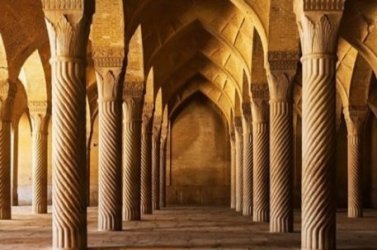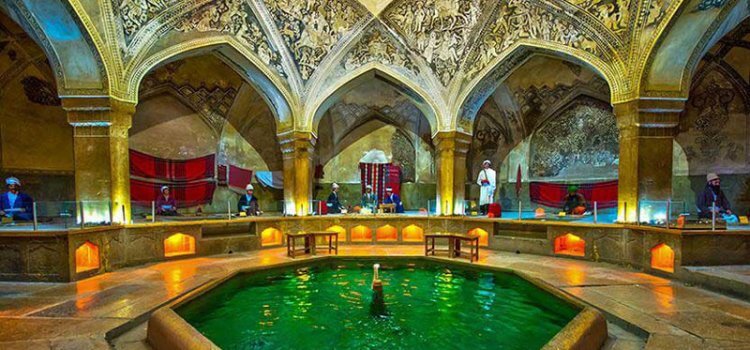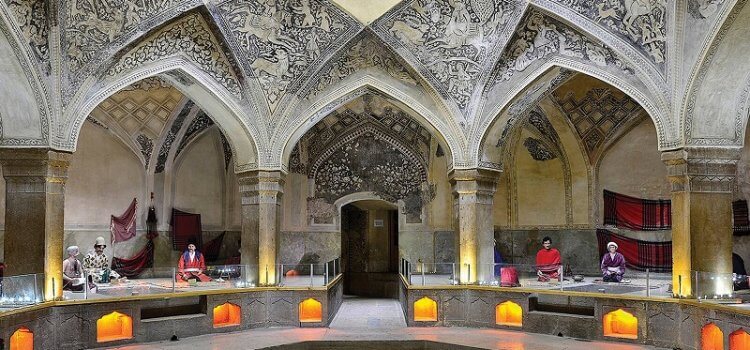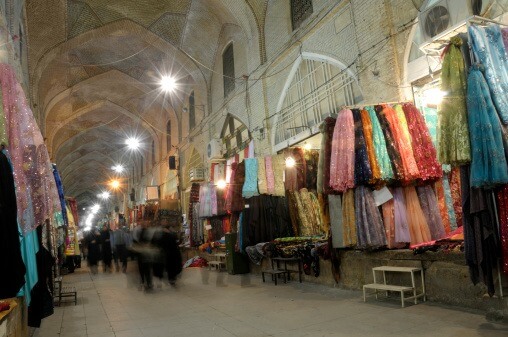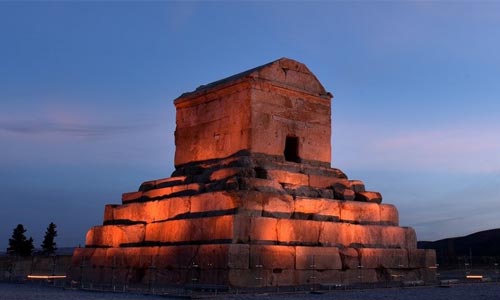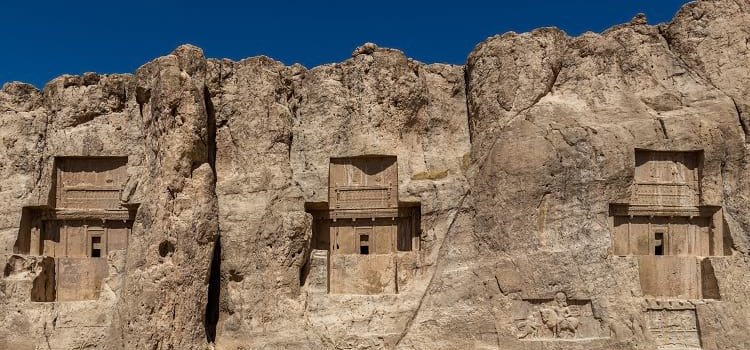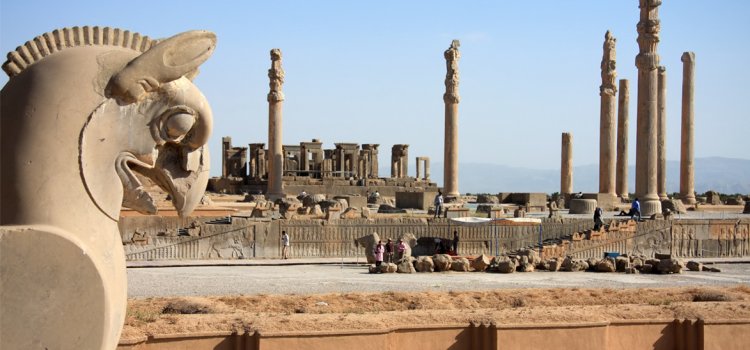Vakil Mosque
Vakil Mosque
Another amazing attraction in Vakil Complex and Shiraz is Vakil Mosque. The harmonious architecture of the mosque and the sense of spirituality it implies are the two basic characteristics which turn this religious site into a cultural and touristic sight.
As part of Karim Khan’s plan to create a new center of town, Vakil mosque was built in the year 1773. The entrance of the mosque, reconstructed during the Qajar period (19th century), is adorned with tiled stalactites, calligraphy, stone friezes and beautiful tile-work which bear mostly pink floral patterns.
As you pass the wooden entrance gate, you will enter a vestibule which takes you to the courtyard of the mosque through a corridor with a 90-degree rotation in relation to the axis of the portal. This cozy rectangular courtyard includes a large rectangular pond in the center, providing the necessary water for the people who come to pray in the mosque. The Eastern and Western sides are covered with two corridors, decorated with arcades.
On the southern and northern sides of the mosque, there are two porches. The northern porch, also called the Pearl Arch, is flanked by two minarets and includes a high vault, decorated with colorful tiling and a beautiful inscription in tholth script representing some versus of the Holy Quran.
The southern porch of the Vakil Mosque leads to the main prayer hall of the mosque which is also the high-light of the mosque. The southern prayer hall of Vakil Mosque is decorated with 48 spiral pillars, in form of tree of life. This special atmosphere creates a spiritual environment where visitors can detach themselves from the ordeals of everyday life and immerse themselves in a universe beyond our material world. As a tip, we should say that you can also take very unique photos for your social media in this prayer hall and among its columns which create unique perspectives.
Another highlight of this prayer hall is its artistically designed mihrab or altar. The plinth on the left-side of the altar is carved out of a single block of a marble. Also, be sure not to ignore the tall, marvelous pulpit of the mosque, built out of green marble.
Shahcheragh Shrine in Shiraz
Shahcheragh Holy Shrine is the third biggest pilgrimage site in Iran after the Holy Shrine of Imam Reza (the 8th Shiite Imam) and Fatimah Masumeh in Qom.
Shahcheragh Shrine in Shiraz
Known as the city of wine and poetry, Shiraz is an ideal city for tourists visiting Iran. It is home to palaces of ancient rulers of Iran such as Pasargadae and Persepolis, magnificent gardens, beautiful orange groves, splendid monuments like Nasir al-Mulk Mosque, tombs of unrivaled Iranian poets, for example Sa’di and Hafez, and also a group of war-blooded people whose hospitality is known around the world.
However, apart from all the beauties mentioned above, Shiraz also houses one of the most sacred shrines in Iran, Shahcheragh Holy Shrine. Actually, it is the third biggest pilgrimage site in Iran after the Holy Shrine of Imam Reza (the 8th Shiite Imam) and Fatimah Masumeh in Qom.
Housing the bodies of Imam Reza’s two brothers, Ahmad and Mohammad, the first monument in this site was built over the grave of Ahmad in the 13th century. Apart from its religious significance, the holy Shrine of Shahcheragh is an architectural gem and that is why it is visited by thousands of travelers and tourists each year. The mirror-work decorations in this shrine will leave you amazed for a long long time.
So, if you are in Iran and visiting Shiraz, make sure to pay homage to these two brothers and also enjoy the unique work of Iranian artists that you will see in no other sight in this country.
What does “Shahcheragh” mean?
Well, the first interesting thing to know concerns the name of this shrine, Shahcheragh. Literally, Shahcheragh means “the King of the Light.” But why the king of the light?
Years ago, in a dark night, one of the most significant clerics of Shiraz, Ayatullah Dastghaib, noticed a strange light in the graveyard which located in this neighborhood. As this event occurred for several times, the Ayotullah decided to investigate the source of the light. After some attempts, he finally discovered that the light emanated from a grave within the graveyard. So, the grave emitting that peculiar light was excavated, revealing a body wearing an armor. As they searched the body more carefully, a ring was found bearing the words al-‘Izzatu Lillāh, Ahmad bin Mūsā, meaning “The Pride belongs to God, Ahmad son of Musa”. Thus, it became clear that this was the burial site of the sons of Imam Mūsā al-Kāzem and the brothers of Imam Reza.
The History of Shahcheragh Shrine
Escaping the persecution of shia Muslims during the Abbasid rule in Iraq, Ahmad and Mohammad came to Iran and took refuge in Shiraz
Ahmad came to Shiraz at the beginning of the 9th century and passed away there. In the 13th century, Atabak Abu Bakr ibn Sa’d (1226–1260) of the Salghurid dynasty, the chief minister to the monarch Amir Muqarrab al-Din Mas’ud, built the first tomb chamber, dome, as well as a colonnaded porch over the grave of Ahmad.
This monument remained the same for approximately 100 years when further work was initiated by Queen Tashi Khātoon (the mother of Shāh Ishāq Injū) during the years 1344-1349. She carried out a number of necessary repairs, built an edifice, an audience hall, a fine theological school, and a tomb for herself on the southern side of the Shrine. She also endowed the shrine with a unique Qur’an of thirty volumes, written in golden thuluth script with gold decoration, in the style of the calligrapher of the day, Yahya Jamali. The date on the Qur’an shows that they were written between the years 1344-1345. Unfortunately, nothing now remains of the buildings constructed by Queen Tashi Khātoon, but the Qur’ans are preserved in the Pars Museum of Shiraz.
The shrine was once more repaired in 1506 (under the reign of Shāh Ismail I) by its guardian, Mirza Habibullah Sharifi. However, half of the structure collapsed due to an earthquake and was again repaired in 1588. During the nineteenth century, the shrine was damaged several times and was subsequently repaired. In 1827, Fath Ali Shāh Qajar endowed the shrine with an ornamental railing. But, another earthquake hit the shrine in the year 1852. This time, it was Muhammad Nasir Zahir ad-Dawla’s turn to repair it.
Finally, the late Nasir al-Mulk repaired the dome. However, because of numerous cracks, the whole dome was replaced with an iron structure in 1958. This Iron structure, built in the shape of the original dome, was much lighter and likely to last longer. The present building consists of the original portico with its ten columns on the eastern side, a spacious sanctuary with lofty alcoves on four sides, a mosque on the western side of the sanctuary, and various rooms. There are also numerous tombs in the vicinity of the Mausoleum.
The Architecture of Shahcheragh Shrine
The decorative art including delicate patterns of mirror-work, the stucco inscriptions, the ornamentation, the gates covered with silver panels, the portico, and the large courtyard are the most attractive parts of the shrine. The tomb, with its latticed railing, makes an alcove located between the space beneath the dome and the mosque. The tradition of placing the tomb in this position, so that it is not directly under the dome, is to be seen in other famous places of pilgrimage in the city of Shiraz, and may be considered a special feature of Shiraz shrines. Two short minarets, situated at each end of the columned portico, add impressiveness to the Mausoleum, and to the spacious courtyard, which surrounds it on three sides.
The Shah-e-Cheragh Mausoleum was registered on 10 February 1940, under No. 363 in the list of the national monuments of Iran.
All in all, visiting the Shahcheragh Shrine is a spiritual journey which you will never forget, so make sure to visit this sacred tomb while you are in Shiraz.
Saadieh
As a traveler to Iran, you may have heard a lot about Shiraz. It is famous for having Pasargadae and Persepolis in its vicinity, for its orange groves or Naranjestans, its warm-blooded people and also for the well-known Persian poets buried in this city.
Saadieh or the Tomb of Sa’di
As a traveler to Iran, you may have heard a lot about Shiraz. It is famous for having Pasargadae and Persepolis in its vicinity, for its orange groves or Naranjestans, its warm-blooded people and also for the well-known Persian poets buried in this city.
Among all the masters of Persian poetry resting in peace in Shiraz, the 13th century poet, Saadi, occupies an outstanding position. Saadi is one the pillars of Persian poetry whose unprecedented wisdom is still alive among Iranians. And it may actually work for the whole world. Just have a look at the lines below and decide for yourself:
Human beings are members of a whole,
In creation of one essence and soul.
If one member is afflicted with pain,
Other members uneasy will remain.
If you’ve no sympathy for human pain,
The name of human you cannot retain
And Saadi didn’t reach such wisdom and high position in Persian poetry just by his mastery over Farsi words, but through long years of traveling and meditating on different cultures in specific and human condition in general.
Walking the skies over the Persian culture, it would be no exaggeration if we say that he has secured an almost sacred position among Iranians, both his contemporaries and even today’s modern Iranians. Nowadays, his tomb, the home of wisdom and sagacity, laying in a big garden and among orange blossoms, is turned into a pilgrimage site, visited daily by hundreds of his passionate lovers and also foreign visitors coming to see the city of Shiraz.
All in all, visiting the tomb of Saadi, which is an architectural gem in its own right, is one the must things to do while you are in Shiraz.
A Short Biography of Saadi of Shiraz
Abu Mohammad Moshref al-din Muslih ibn-Abdallah, known mostly by his penname as “Saadi”, one the most important Persian poets and prose writers, was born in Shiraz around 1209-10.
Although Saadi’s father does not appear much in his poetry and prose writing, it is certain he played a major role in Saadi’s life. As Literary historians tell us, Saadi’s father was his first educator, teaching him lessons in forbearance that remained with him all through his life. Howere, this evidently wise father departed the world soon and left Saadi an orphan.
However, while still an adolescent, Saadi travelled to Iraq to study in the then world-famous Nezamiyeh School of Baghdad. After his studies, it is believed, he travelled to different parts of the Middle East and visited countries such as Iraq, Syria, Palestine and the Arabian Peninsula.
When Saadi came back to Shiraz around 1257 after some 30 years of travel, he was already a well-known and established poet, mainly due to the wide circulation of his unique ghazals or odes.
However, he is mostly known among Iranians by his two great works, Bustan and Golestan. Bustan, literally meaning “Garden of Fragrance” or “Pleasure Garden,” is a moralistic and anecdotal verse work consisting of some 4,100 masnavi couplets, finished in 1257. It is divided into ten chapters, namely: 1. On justice, good management of affairs, and good judgment; 2. On beneficence; 3. On love, intoxication, and passion; 4. On humility; 5. On acceptance; 6. On contentment; 7. On the world of edification; 8. on gratitude for being in good estate; 9. on repentance and taking the right course; 10. On close communion (with God). The titles, also given in the preamble, provide a rough guide to their respective contents.
Gulestan, completed a few years later, is one of the most influential works in Persian prose. It mostly contains material which he had intended to use as part of Bustan, but didn’t find enough space or time. As Franklin Lewis states: “striking the proper balance between the exercise of efficacious power and of enlightened moral authority in political relations, and the assertion of self-interest versus humane altruism in interpersonal relations, are central concerns throughout the Golestān.” The book is divided into chapters, each one containing various stories: “On the Conduct of Kings” (41 stories), “On the Morals of Dervishes” (48 stories), “On the Excellence of Contentment” (29 stories), “On the Benefits of Silence” (14 stories), “On Love and Youth” (21 stories), On Frailty and Old Age (9 stories), On the Effects of Education (tarbiat, 20 stories), On Manners (non-narrative aphorisms and maxims).
Reaching a revered position among his people, Saadi died in 1291 or 1292. However, his name is still alive as his readers still find wisdom and meaning in his everlasting works.
A Short History of the Tomb of Saadi or Saadieh
The tomb of Sa’di was first used as his monastery. In the 14th century, for the first time, Shamsuddin Muhammad, the minister of Abaqa Khan, the second king of the Ilkhanid dynasty, built a tomb above Sa’di’s grave. During those days, people of Shiraz used to wash their clothes in the marble pools of Sa’di’s tomb, since they believed the water flowing in those pools had healing powers.
But unfortunately, in the year 1590, Sa’di’s tomb was totally destructed by the order of Yaqub Zolghadr.
However, Karim Khan Zand ordered the construction of another mausoleum over Sa’di’s grave in 1773. This plaster and brick monument included two-stories: the first floor of the building contained two rooms on its Eastern and Western sides and a corridor leading to the second floor. Covered with a wooden structure, Sa’di’s grave was located in the Eastern room. The second floor, mostly followed the plan of the first one with one exception: as a sign of respect to the great poet, no room was built on top of Sa’di’s grave. Much later, the Western room became the burial place of Shoorideh Shirazi (1857- 1923), another great Persian poet.
Based on historical sources, Saadi was accused of being Sunni in the early Qajar period. Therefore, his tombstone was destroyed by the order of one of the Shia scholars of Shiraz. Yet, a while later, Ali Akbar Khan Qawam al-Mulk-e Shirazi, one of the political figures of the time, replaced Saadi’s tombstone with a new one. This tombstone, decorated with some of the poems of Bustan, stayed over Sa’di’s grave for a long time until the construction of the current building began.
In 1922, the tomb of Sa’di underwent reconstruction once more. This time, Fath Ali Khan Sahib Divan, the son-in-law of Fath Ali Shah, restored this building. Then, Habibullah Khan Qavam al-Mulk, of the famous Qavam al-Mulk family in Shiraz, ordered the reconstruction of some parts of the building. Then, Karbalaei Seyyed Zin al-Abedin Chini (Hosseini Nik) was appointed to continue the construction of the tomb.
About 20 years later, a branch of the National Heritage Association, under the direction of Professor Ali Sami, was established in Shiraz in 1945. Professor Sami and his team passionately pursued the idea of reviving the Saadieh Complex. To provide the necessary budget for this project, based on a government decree in 1946, the Marvdasht sugar factory was obliged to support this great cultural cause.
The decree dictated that two rials of the money raised by selling each kilogram of the sugar produced by the factory should have been allocated to the renovation of the complex. Nevertheless, this was only a small attempt at preserving the Tomb of Sa’di. Nevertheless, the serious endeavors to reconstruct the monument began in 1948. At the time, Ali Asghar Khan Hekmat was appointed as the president of the National Heritage Association and the Secretary-General of UNESCO in Iran, and Ali Sami was working as the secretary of the National Heritage Association in Shiraz.
In 1948, the mausoleum built over the grave of Sa’di by Karim Khan Zand was still in place. However, the French architect and historian Andre Godard, the director of archeology in Iran at the time, was invited to Shiraz and give his opinion on this subject.
After Godard’s visit and the discussions which took place in the following year, the National Heritage Association signed a contract for the design of Sa’di’s tomb with a construction company. So, the engineers Mohsen Foroughi and Ali Sadegh began designing what is today known as Sa’dieh, or the tomb of Sa’di.
The new tomb of Saadi, the result of work of a group of Iranian designers and architects and workers from Shiraz, was completed in March 1951. Inspired by Chehel Sotoon’s design, the monument represented a mixture traditional and modern architectural styles in Iran. With a final cost of about 980,000 tomans and occupying an area of 7700 square meters, the tomb of Sa’di was inaugurated on the afternoon of May 1st, 1952.
After the Islamic Revolution, in the year 2001 and during the development plan of the tomb, Shiraz Municipality, in cooperation with the Housing and Urban Development Organization, initiated a project to expand Sa’dieh, reaching 4.5 hectares.
The Architecture of Sa’di’s Tomb
What you can see today as the mausoleum of Sa’di wass the work of Mohsen Foroughi, an Iranian modernist architect who designed the tomb in cooperation with Ali Akbar Sadegh in 1951.
Inspired by traditional Iranian architecture, the tomb building has an infrastructure about 257 square meters. From the outside, the building resembles a cube. However, from the inside, boasts an octagonal plan, embellished by a magnificent azure dome and marble walls. The exterior of the tomb is of travertine. The foundation stones of the building are black, the front end of the porch and also the columns are of special red granite.
The Azure Dome
The main building housing the grave of Sa’di is embellished with white stones and tiles. And the 8 columns of brownstones in front of the tomb remind us of the columned porches of the Safavid period. In addition, a dome of turquoise tiles standing on top of the building shows off its beauty by sparkling under the glowing sun of Shiraz.
The main building of the tomb includes two iwans or porches, built perpendicular to each other. The tomb of Sa’di lies in the corner between these two iwans, right in the middle of the octagonal mansion. Also, seven inscriptions decorate the seven sides of the building.
These poems are from Bustan, Golestan or other poems of this great Iranian poet. The beautiful calligraphy is the work of the great calligrapher, “Ibrahim Bouzari”. Among the inscriptions containing the poems of Sa’di, one inscription includes the words of “Ali Asghar Hekmat”, narrating the story of the construction of the monument.
The Must-See Parts of Sa’dieh
The tomb of Sa’di includes several beautiful parts, some of them with beautiful stories, which you should never miss visiting. So, let us have a walk together in the tomb of Sa’di and get familiar with its different sides.
The Entrance and the Garden of Sadieh
To enter Saadi’s tomb, we should pass through the gate of the mausoleum, built exactly in front of the entrance of the tomb. If you look carefully, a line of poetry adorns the green metal of the entrance gate:
The fragrance of love spreads from Sa’di of Shiraz’s grave,
If you would smell it even after a thousand years.
Passing by the gate, we enter the garden and you will walk to the tomb of Sa’di through a walkway, including two large ponds in the middle in the north-south direction and flanked by small gardens. There is also another pond in the east-west direction in front of the main iwan of the tomb. Finishing the walkway, as mentioned before, we enter Sa’di’s tomb, occupying an area of about 10395 square meters.
Sa’di’s Poems Embellish His Tomb
One of the most attractive parts of Sa’di’s tomb, what gives you a mystical feeling inside the tomb of this great dervish, is reading Sa’di’s poems, written on the doors and the walls surrounding his grave. One of the inscriptions of Sa’di’s poems is on a piece of stone which has a story to tell.
This piece of stone is part of a stone inscription which was placed on the entrance of the tomb during the Karim Khan Zand’s rule. Due to an accident, this inscription was broken years ago. But fortunately, it was found while digging the surrounding streets to repair the asphalt.
Water in Sa’dieh
Generally speaking, Sa’dieh has a plan of the famous Persian gardens. As you may know, water plays a great role in Persian Gardens. So, let’s get familiar with the different qanats (joined water wells) and pools flowing in the tomb of Sa’di. But before that, let us mention a historical point: It is widely believed that Sa’di had several pools of marble next to his praying room.
Sa’dieh Qanat
The Qanat irrigating Sa’dieh complex is located at a depth of ten meters below the courtyard of the tomb. And its water contains sulfur and mercury. The water of this qanat flows underground and eventually flows into a pool called “the fish pool”.
Fishpool
An octagonal pool lies on the left side of the tomb, about 20 meters west of it. The size of the pool is about 30.25 square meters.
This pool is known as “the Fish Pool”. It lies in a chamber below the garden’s surface, connected to it with a flight of 28-stairs.
What Locals Believe About This Pool
Once, locals believed that washing in this water, especially on the last Wednesday night of the year (or, Chahar Shanbeh Soori) was a blessing. And this idea remained with the people of Shiraz for a long time.
However, after the construction of Sa’di’s tomb, swimming in this pool was banned. Nowadays, some 150 meters away from the tomb, there is a place where water flows on the ground and is known as Saadi Bath Alley. People go to this place and swim in the water. They believe this water is sacred and washing in it will grant their wishes.
For a long long time, Shirazi people have believed that this water does magic and can solve their daily problems. Interestingly, farmers take a container of this water to pour into their fields to have an abundant harvest and better quality crops. It is also believed that washing clothes in this water will protect them from getting sick. Or if they are sick, it will help them heal sooner.
The Legendary Golden Fish
In the past, people came together in this place to cook Ash, or what the locals call “Dig Joosh”. And cooking this Ash was a lot of fun. Shirazi people believed that there was a goldfish in the water with a golden ring on its nose. According to them, it jumped up and down in the water and played. Also, no one went fishing there. Why? Because catching the Gold Fish meant bad luck.
The tiles inside the fish pool closely resemble the ones from the Seljuk era (12th century). However, it was master Tirandaz, a famous tile worker in Shiraz, who designed them and then the Cultural Heritage Office in Shiraz used them to decorate the Fish Pool in 1993.
There is an octagonal skylight above the fish pool plus two other four square skylights on its sides. In the past, people used to drop coins in this pool to have their wishes realized. Nevertheless, since there is no water in this pool any longer, people have opted another pool to throwing their coins in.
Coin Pool – A New Pool for the Wish Coins
After the fish pool was drained, people began throwing their coins in another pool. The newly chosen pool is located just in front of the main porch of the tomb. Although it may seem This may seem an activity done for fun now, the philosophy of dropping coins in water goes back to the Mithraic religion in Zoroastrianism.
In this ritual, the water is considered as a symbol of purity and also the goddess Anahita. So, the followers believed that by giving a part of their property to the goddess of water, they bring blessings to their homes. In fact, pouring money into water is a kind of sacrifice, vow, and forgiveness.
Of course, it is good to remind you that water is one of the four sacred elements in the ancient Iranian religions. And its importance and sanctity have been mentioned many times in the Avesta. In Aban Yasht and Tir Yasht (parts of Avesta), there are many sayings about the sanctity of water. And all of them emphasize the praise of Anahita, the goddess of water.
And as you may know, this custom is not limited to Iran. You find the traces of a similar belief in Italy and Russia as well.
Saadi’s Tomb
The tomb of Sa’di is located in the middle of an octagonal building. It is covered with a high ceiling, decorated with a beautiful turquoise dome. The current tombstone of Sa’di was installed there by Ali Akbar Khan Ghavam-ol-Molk Shirazi.
He also placed an inscription engraved with the poems of Saadi’s Bustan on the stone. It’s Nasta’liq calligraphy is excellent.
The Tomb of Shurideh-ye Shirazi
Saadi’s tomb is surrounded by the graves of people who were buried in this place according to their will. One of them is Shurideh-ye Shirazi, the son of Ahli-ye Shirazi, a famous poet of the Safavid era. He was born in Shiraz in 1860 and died in 1927. At the age of seven, the poet became blind and lost sight of both of his eyes due to smallpox. But a few years later he turned into a talented and very popular poet.
The left side of Saadi’s tomb is connected to a portico with seven arches and reaches the tomb of Shorideh Shirazi with a black floor. This tomb is also located in a separate room and has an inscription on it, introducing the poet and one of his poems on the crimson tiles on the wall.
Saadieh Library
On the west side of Sa’di’s tomb, there is a white building with a blue sign at the entrance. This building is the small but prolific library of Saadieh. It attracts every newcomer to immerse himself in a different world of thought, mysticism, and science. It was established in 1972, occupying an area about 105 meters. It has only one hall. There are two sections, including the library repository and the reading room, which are separated by the librarian’s desk.
Other Parts of Saadieh
For Saadieh to be a complete complex, it needs side buildings. And therefore you can see service buildings in it. For this complex to be well received by visitors, a teahouse has been created in its basement.
It provides a suitable space for rest during the visit. Next to the fish pool, there are two brick buildings. One of them is the office of the Saadia complex. And the other is the public library that we talked about before. In another corner of the complex, there is another building which is the bathroom.
Vakil Complex in Shiraz
After a long struggle for power, Karim Khan Zand settled permanently in Shiraz in the year 1765, founding the Zand dynasty
Vakil Complex in Shiraz
After a long struggle for power, Karim Khan Zand settled permanently in Shiraz in the year 1765, founding the Zand dynasty. Interestingly, he declined to assume the title of Shah, calling himself “Vakil al-Ra’āyā” (Deputy of Subjects) or “Vakil al-Khalayegh” (people’s deputy). As Vakil, he used to wear very simple clothes, putting on the tall Zand turban of yellow cashmere and sitting on a cheap, flat-weave rug (zilu) instead of a throne.
With the establishment of his power, Karim khan began building a new series of monuments in shiraz, what is today known as Vakil or Zandiyeh complex. The complex includes the Citadel of Karim Khan, Vakil Bazaar, a mosque and also a bath-house.
The good thing about Vakil Complex is that all these monuments are located closely to each other and you can visit all of them simply by walking. In addition, many other touristic sights are located in the vicinity of this complex and you have easy access to them.
In this article, we are you going to introduce each of these buildings briefly and since these are must-see attractions in Shiraz, we strongly recommend you to read it before visiting these precious monuments
Vakil Bath
Vakil Bath
Just located to the right of the Vakil Mosque, there is the Vakil Bath, built by Karim Khan as one of the largest traditional bath-houses in Iran.
The bath, mainly built of brick, gypsum mortar and stone, includes an entrance portal on its northern side, connecting the outer and the anteroom through a low door with a light slope. This technique used in many of traditional Iranian bathrooms is used to avoid the evasion of hot air from the bath.
The anteroom, adorned with arabesque designs, directs to a chamber used as the dressing room of the bath. This room, which is octagonal in shape, is decorated with eight monolithic stone columns. Furthermore, the walls of the bath are adorned with stucco molding in floral and geometric patterns. Also, a big pool is built in the middle of this room, with some empty spaces around which were used as shoe boxes.
A corridor where the latrines are situated connects the dressing room to what is in Persian architecture called Garm-khaneh or literally the heat house. The heat room enjoys a square plan with four rock columns, topped by a canopy of vaults. Hot water canals passed under the floor covered with stones. The dados are built out of green marble plates, imported from Tabriz. In addition, there are two deep niches with a large stone pool in front of them which were dedicated to the nobiles. The outstanding decorations of this part of Vakil Mosque are the plaster designs created in the Qajarid era (19th century) covering the Zand designs.
Also, the wax figures and a voice-over speaking in the sweet Shirazian accent represent and describe the different procedures of bathing in the Zand era. As it becomes clear little by little, the bathrooms were not only a place used for personal hygiene, but also a gathering place in which different ceremonies were held. A famous marriage ceremony, called ‘Henna Bandan’ in which the groom’s relatives put Henna on bride’s hands as a symbol of joy and fortune, is demonstrated in one the rooms of the Vakil Bath, using wax figures and playing the music played in this ceremony. So, by visiting the Vakil Bath, you will not only get familiar with one of the architectural gems of the Zand period in Iran, you will also get familiar with a number of Iranian cultural traditions. Therefore, make sure not to miss visiting the Vakil Mosque during your trip to Shiraz.
Vakil Bazaar
Vakil Bazaar
One of the highly attractive parts of Vakil Complex, in which every tourist and visitor can spend hours and hours without being bored, is no doubt the Vakil bazaar of Shiraz.
Inspired by the Safavid Bazaar of Lār, a city near Shiraz, Karim Khan ordered the construction of Vakil Bazaar. The completion of the bazaar took about four years, from 1770 to 1774.
The Vakil Bazaar, stretching from North to South, is composed of two perpendicular archways. The Northern and Southern parts of the bazaar, called rasteh, included eighty-two shops, while the Western and Eastern rastehs lodged twenty and thirty-eight shops respectively.
In addition to shops, Vakil Bazaar hosts several workshops, storerooms and caravansaries. The caravansaries in the eastern, western and northern sides of the bazaar are called Rowghani, Ahmadi, Qawami and Gomrok. There is another caravanserai built on the Western wing of bazaar known as Fil caravansary (elephant caravansary). Fil Caravanserai was built in 1766, mostly housing the offices of merchants active in the bazaar. Unfortunately, some parts of Qawami and Rowgani caravanserais, as well as eight arches of the bazaar, were demolished due to urban expansion undertaken during the Pahlavi I era.
Having been an international trade center, Vakil Bazaar now contains 180 shops, mostly selling spices, rugs, carpets, copper handicrafts and antiques. The highlight of the bazaar is the Qajarid Saray-e Moshir, built by Mirza Abolhassan Khan Moshirolmolk in the 19th century. Being located at the southern end of the bazaar, Saray-e Moshir is comprised of a large pool in the middle surrounded by four flower beds and also shops on its western and eastern sides. Local souvenirs and handicrafts are being sold in this bazaar and caravanserai.
The Citadel of Karim Khan (Arg-e Karim Khan)
The Citadel of Karim Khan (Arg-e Karim Khan)
To build his citadel, Karim Khan invited the best national and international architects to come to Shiraz and design the arg. In addition
The Citadel of Karim Khan (Arg-e Karim Khan)
To build his citadel, Karim Khan invited the best national and international architects to come to Shiraz and design the arg. In addition, he ordered the best construction material be brought to Shiraz to be used in building this magnificent citadel.
As you approach the citadel of Karim Khan, its unique brick-work and tall watch-towers attract your attention. Entering the citadel, make sure to spend some minutes probing the painting just above the entrance gate. It represents Rostam, the most famous mythic hero in Iranian culture, killing the white div or demon. The theme of this Qajarid painting (19th century) is borrowed from epic book Shah Nameh (the Book of Kings) by the famous Iranian poet, Ferdowsi.
By the way, passing the entrance gate and vestibule, you will enter the courtyard of the citadel. Following the general plan of well-known Persian Gardens, the courtyard is divided into several orange groves and four ponds at the four corners of this appealing garden. Again, confirming the general pattern of Persian Gardens, the longest pool is located on the eastern side of the complex, right in front of the door you entered the courtyard.
On the Western, Northern and Southern parts of the citadel, there are three porches, each one decorated with two high-rising columns. Flanking these porches, there are rooms in various sizes which once hosted both the family of Karim Khan and his formal guests.
Inside the rooms, you can feast your eyes on beautiful decorations such as arabesque and floral patterns featuring Persian flower and bird (Gol-o morgh) motifs. These patterns, which were mostly common in Shiraz, were painted in vivid colors and gilt on the upper parts of the walls and ceilings. The ceiling’s ornaments were painted using herbal colors and gold plates. Furthermore, the interior used to be abundantly decorated with tiles, marbles, plaster works and gilded paintings. In addition, large mirrors, brought from Russia, Europe, and Ottoman lands were installed here.
The outer façade of the rooms, especially their plinths, are decorated with large carved stone panels, bearing designs mostly borrowed from Persepolis.
Pasargadae
Pasargadae, the city that hosts the tomb of Cyrus II, the great founder of the Achaemenid dynasty.
The site was not destroyed like Persepolis after the conquest of Alexander the Great. But its gradual abandonment meant that the stones of the palaces served as building materials for the inhabitants of the surrounding villages.
Only the tomb of Cyrus II was spared from destruction.
Alexandre paid homage to his remains during his visit to the city. The Muslim attackers respected the burial place of Solomon’s mother, the Prophet, which is there according to the local legends.
Archaeological excavations have brought to light the water canals over most of the site, which shows the existence of a large garden, a Royal Garden. These are the oldest Persian gardens, which served as a model for the famous Iranian gardens, “Pairi-Faeza” origin of the word paradise.
From the entrance to the site, you can see the famous tomb, enthroned in the middle of an esplanade, a double-roofed building on a stepped plinth. Some shuttles take you to the end of the site to visit the palaces, which are in deplorable condition today. There is a cubic tower of which only one side remains, built according to the same architecture as the Kaabeh-Zartosht in Naghshe Rostam.
At the “Entrance Palace” , on the sides of a door, a half-man, half-god figure with various symbols is represented. Some historians take it for a representation of Cyrus, without any certainty.
Naghshe-Rostam
Naghshe-Rostam, literally the image of Rostam, is the necropolis of the Kings of ancient Persia
Naghshe-Rostam, literally the image of Rostam, is the necropolis of the Kings of ancient Persia. The site was named by the locals over the Sassanid bas-reliefs evoking the story of a hero in the Book of Kings, Shahnameh of Ferdowsi.
The rock shelters the burials of four Achaemenid kings, all of them are cruciform. In front of the reliefs, there is a building in the shape of a cube, called the Kaabeh-Zartosht. Its function remains unknown until now. Perhaps it was a temporary tomb or a fire temple.
Below the entrance to the four tombs carved into the rock are several bas-reliefs. The most importants are the one that Shapour is appearing on horseback, holding the hand of a Roman emperor Valerian and the other who is kneeling is the Emperor Philippe the Arab, the first one is captured and the other is paying the ransom demanded to regain his freedom.
Two equestrian scenes showing the victories of the Sassanid kings against their Roman rivals. And further on, we can see the representation of the investiture of Ardeshir, the father of Shapour, receiving the ribboned diadem directly from Ahuramazda, the supreme god of the cult of Zoroaster, symbolizing and affirming the legitimacy of the rule of the Sassanids.
The Zoroastrian religion became politicized from this point on, and priests played a predominant role on the political scene.
Persepolis
Persepolis is the most majestic city that the Achaemenid kings have built
Persepolis is the most majestic city that the Achaemenid kings have built. Started by the order of Darius, 520 BC, the rock had to be raised to find the extent necessary for its construction and to fit out the palaces and halls of various names and functions.
Architects and craftsmen from different regions are engaged in the work to create an artistic symbiosis representing all the people forming part of the empire and subject to the undisputed power of the Achaemenid rulers.
The heart of the site is a courtroom called Apadana. This is the courtroom where the representatives of the nations were received. They were on their way to Persepolis on New Year’s Eve, bringing their gifts to the Emperor. The representation of a procession of guests has been brought to light on the stairs of the Apadana.
Two tombs were built on the rock, behinde of the site, belonging to the kings of this Achaemenid dynasty.
The city succumbs to the sacking and the raging fire of Macedonian soldiers in 333 BC. The radiance of a lavish and unparalleled period was thus extinguished, consumed by this fire.

